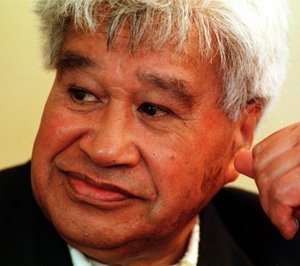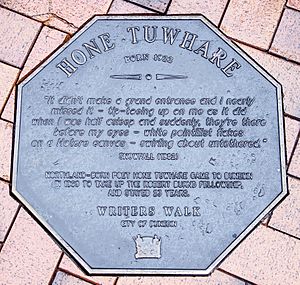Hone Tūwhare facts for kids
Hone Peneamine Anatipa Te Pona Tūwhare (born October 21, 1922 – died January 16, 2008) was a famous Māori New Zealand poet. He spent the later part of his life in The Catlins area, which is in the Southland region of New Zealand.
Contents
Hone Tūwhare's Early Life
Hone Tūwhare was born in Kaikohe, Northland. He belonged to the Ngapuhi tribe. When his mother passed away, his family moved to Auckland. Hone went to primary schools in Avondale, Mangere, and Ponsonby.
He became a boilermaker apprentice with the New Zealand Railways. He also took night classes in subjects like Mathematics and Trade Drawing at Seddon Memorial Technical College and Otahuhu College. Hone spoke Māori until he was about nine years old. His father was a great storyteller and speaker, and he encouraged Hone's love for words, especially the rhythm and pictures found in the Old Testament.
His Journey as a Poet
Hone Tūwhare started writing in 1939. Another poet, R.A.K. Mason, encouraged him while he was working as an apprentice at the Otahuhu Railway Workshops.
In 1956, Tūwhare began writing poetry more seriously. His first book, and probably his most famous, was No Ordinary Sun. It was published in 1964 and was very popular. It was reprinted ten times over the next 30 years, becoming one of the most widely read poetry collections in New Zealand.
When Tūwhare's poems first came out in the late 1950s and early 1960s, they were seen as something new in New Zealand poetry. Many people liked them because they showed a clear Māori point of view. His poems were known for their different tones, moving easily between serious and funny, sad and angry. They also felt very natural and familiar to New Zealand readers.
During the 1970s, Tūwhare became involved in Māori cultural and political activities. At this time, his fame also grew internationally. He was invited to visit countries like China and Germany. This led to his book Was wirklicher ist als Sterben being published in 1985.
He kept writing new poems even as his older works stayed popular. Tūwhare's play, "In the Wilderness Without a Hat," was published in 1991. After that, he released three more poetry collections: Short Back and Sideways: Poems & Prose (1992), Deep River Talk (1993), and Shape-Shifter (1997). In 1999, he was named New Zealand's second Te Mata Poet Laureate. This led to his book Piggy-Back Moon (2002).
In 1992, the poet moved to Kaka Point in South Otago. Many of his later poems were inspired by the beautiful scenery of The Catlins area and the seafood there. He worked closely with another Otago artist, Ralph Hotere, and their art often referred to each other's work.
In 2007, Tūwhare's poem "Rain" was voted New Zealand's favorite poem by a large number of people. His poetry was also part of UPU, a collection of works by Pacific Island writers. UPU was first shown at the Silo Theatre in March 2020 and again at the Kia Mau Festival in June 2021.
Awards and Special Recognition
Hone Tūwhare received the Robert Burns Fellowship from the University of Otago in 1969 and again in 1974. He also received the University of Auckland Literary Fellowship in 1991.
In 1999, he was named New Zealand's second Te Mata Poet Laureate. After his two-year term, he published Piggy Back Moon (2001), which was a finalist for the 2002 Montana New Zealand Book Awards.
In 2003, Tūwhare was one of ten great New Zealand artists named as Arts Foundation of New Zealand Icon Artists. Also in 2003, he received one of the first Prime Minister's Awards for Literary Achievement for poetry. He shared this honor with novelist Janet Frame and historian Michael King. Each winner received $60,000 NZD. These awards celebrate New Zealand writers who have made a huge impact on the country's literature and culture.
The University of Auckland gave Tūwhare an honorary Doctor of Literature degree in 2005. When he passed away, Hone Tūwhare was called "New Zealand's most distinguished Maori writer."
The Hone Tūwhare Charitable Trust
In July 2010, the Hone Tūwhare Charitable Trust was created to honor him. Their main goal is to "inspire people through the preservation, promotion, and celebration of Hone’s legacy." This means they work to keep his memory and his work alive for future generations.
Hone Tūwhare's Published Works
- No Ordinary Sun, Auckland, Blackwood and Janet Paul, 1964
- Come Rain Hail, Dunedin, University of Otago, 1970
- Sapwood and Milk, Dunedin, Caveman Press, 1972
- Something Nothing, Dunedin, Caveman Press, 1973
- Making a Fist of It, Dunedin, Jackstraw Press, 1978
- Selected Poems, Dunedin, McIndoe, 1980
- Year of the Dog. Dunedin, McIndoe, 1982
- Was wirklicher ist als Sterben, Straelen, Straelener-Ms.-Verl, 1985
- Mihi: Collected Poems, Auckland, Penguin, 1987
- Short Back & Sideways, Auckland, Godwit, 1992
- Deep River Talk: Collected Poems, Honolulu, University of Hawaii Press, 1994
- Shape-Shifter, Wellington, Steele Roberts, 1997
- Piggy-back Moon, Auckland, Godwit, 2001
- Oooooo......!!!, Wellington, Steele Roberts, 2005
- ‘’ Friend ‘’,Whangarei, Noah
See also
 In Spanish: Hone Tuwhare para niños
In Spanish: Hone Tuwhare para niños



